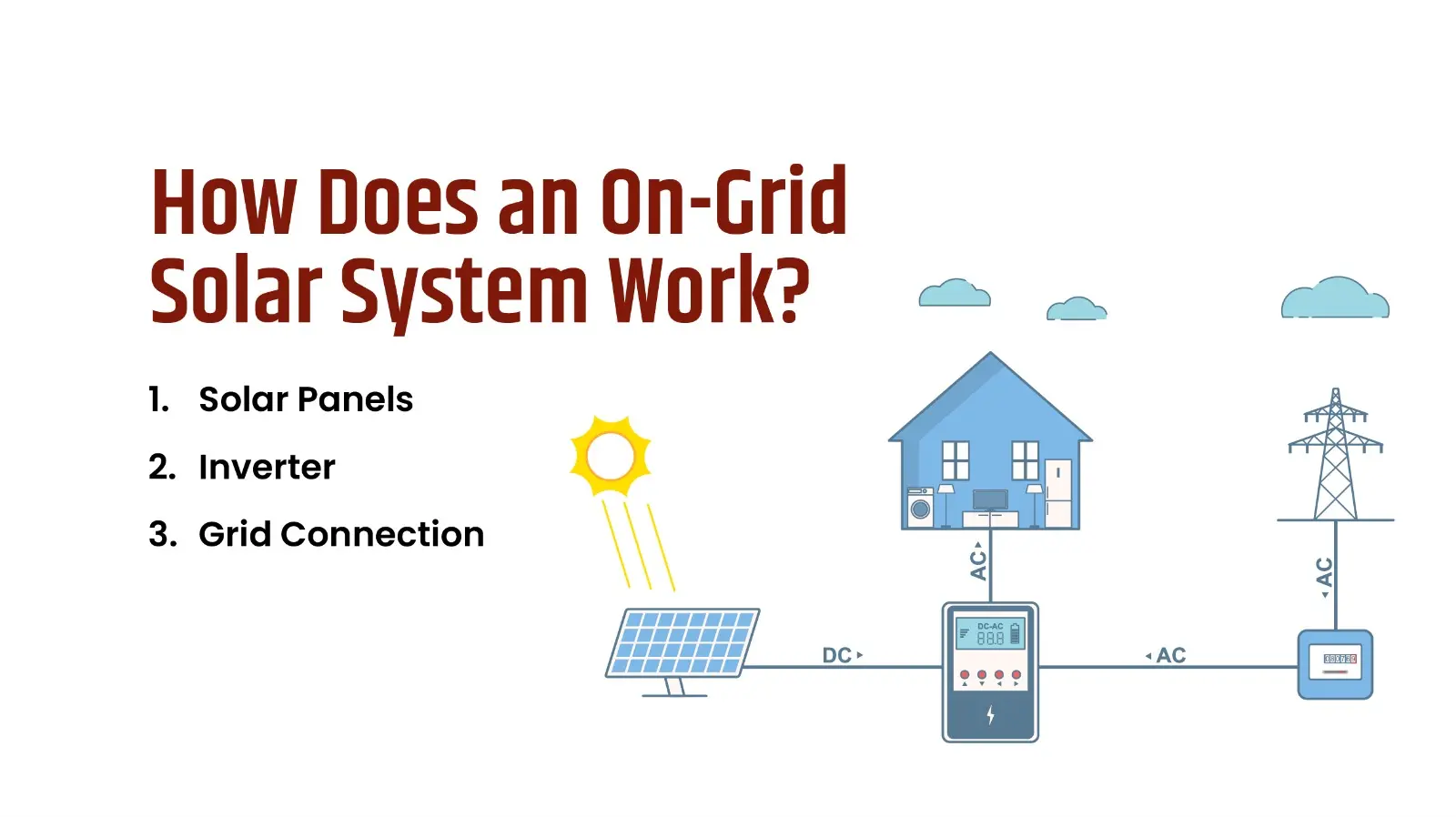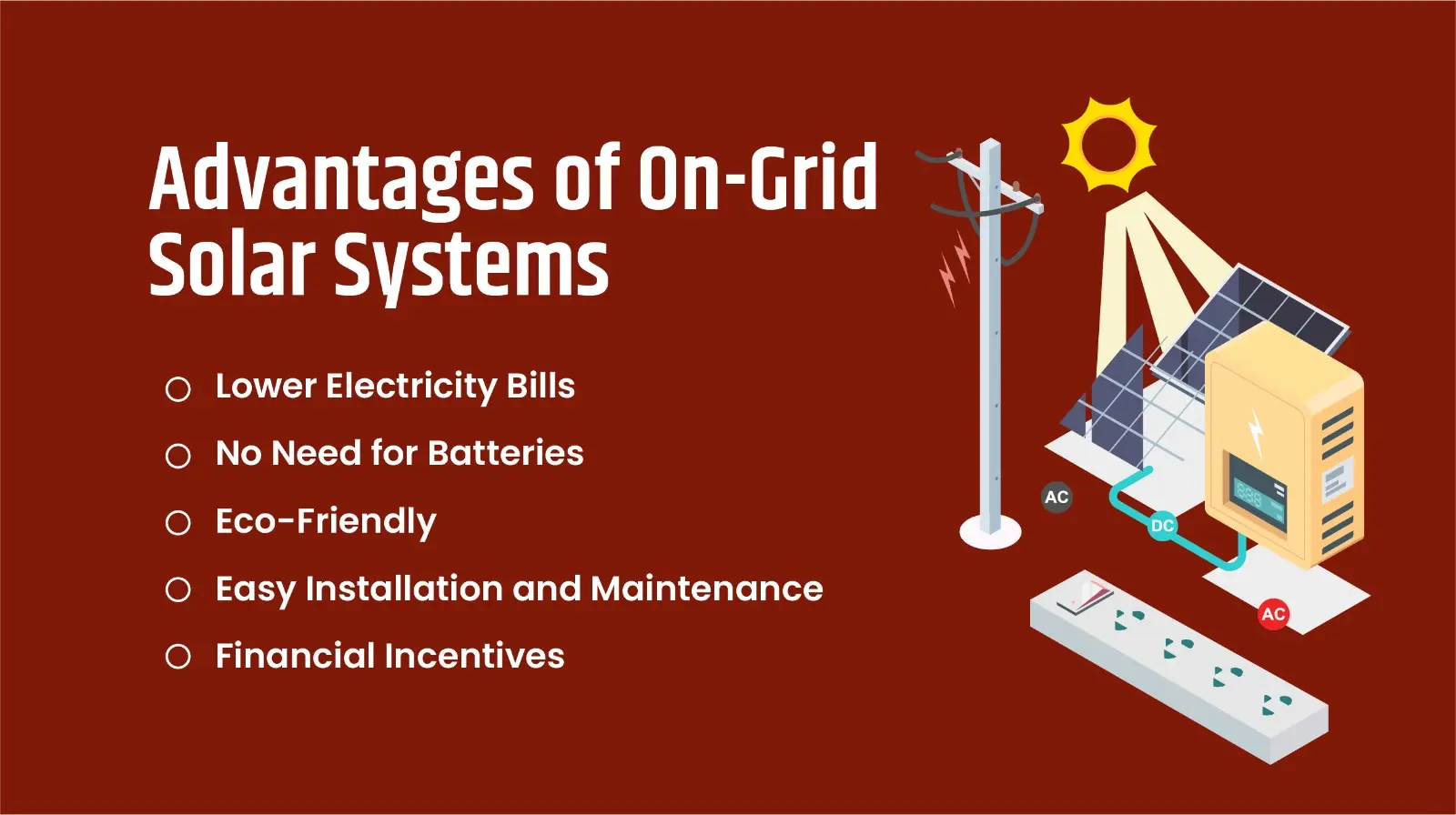What is an On-Grid Solar System?
An on-grid solar system uses sunlight during the day to power your home 24/7. This is a cutting-edge system that is connected to the local grid. This not only lets you produce your own clean energy but also gets backup from the grid on cloudy days or nighttime.
Curious about the way this eco-friendly, cost-effective solar solution can change the way you power your life? Read on.
How Does an On-Grid Solar System Work?

With the help of photovoltaic panels, an on-grid solar system converts solar energy into electricity. Let's look into the process that is carried out
1. Solar Panels
Solar panels (PV panels) are one of the vital components of an on-grid solar system. When the sunlight hits the surface, the solar cells react and generate an electric current. It's direct current (DC).
Read more here: How photovoltaic panels create power.
2. Inverter
Now, solar panels create electricity in DC that can't be used by your home appliances. An on-grid solar inverter is what helps make alternating current (AC) electricity out of direct current. The AC electricity then powers your home appliances.
3. Grid Connection
Like an off-grid solar system, the on-grid solar system usually doesn't have solar batteries attached to it. Instead, it's directly connected to the local utility grid. Which means any excess electricity can be sent back into the grid. And the best part is receiving credits through Net Metering. This helps reduce your electricity bills to a great extent.
Advantages of On-Grid Solar Systems

There are benefits of installing an on-grid solar system. Let's go through a few of them.
1. Lower Electricity Bills
On-grid solar power systems greatly lower electricity bills. As you know, solar panels generate electricity throughout the day to power your home, you don't have to rely on external energy sources. And the excess energy fed to the grid earns you credits lowering your bills further.
2. No Need for Batteries
Unlike off-grid solar systems, an on-grid solar system can function well without solar energy storage. With its connectivity to the grid, during cloudy days or nights you can rely on the grid for power. It's an affordable option too, because batteries cost a lot.
3. Eco-Friendly
There's no harm in properly using solar energy. And when it comes to producing electricity, on-grid solar power systems are a clean and green medium. Getting an on-grid solar system installed won't just end your use of fossil fuels but also reduce your carbon footprint.
4. Easy Installation and Maintenance
There is no complexity involved in the installation process of an on-grid solar system. These solar systems are easier to install considering the simple components. They also require very little solar maintenance services, just the periodic cleaning of the panels will do!
5. Financial Incentives
With the increase in financial incentives and subsidies, these on-grid solar power systems are gaining popularity. The subsidies for the installation make the investment a lot more affordable.
Installation Process of an On-Grid Solar System
Step 1: Site Assessment and Energy Needs Evaluation
The primary thing to be accomplished is the assessment of all crucial factors that will play out in the whole system. This will include the site, energy consumption, and others. These factors will influence your decision on what type and size of system you will purchase and how much electricity requirement you will need to meet.
Step 2: Choosing the Right Components
You may definitely believe in the fact that good quality always helps in the long run. Similarly, high-quality components will make a smooth running and efficient on-grid solar system. Make sure you pick out the best solar panel components, batteries, wiring and inverters to maximise your benefit.
Step 3: Installing the Solar Panels
Assembly of all the components you have carefully picked is your next step. The setup for an on-grid solar system includes installing solar panels in the decided area at a correct angle. This is done to maximise sunlight exposure.
Most commonly, you would have seen rooftop mounted solar panels. However, these are just one out of all the different types of solar mounting structures. You will also need to complete wiring work before they are connected together to function.
Step 4: Inverter and Grid Connection
An on-grid solar inverter is the most important component as it helps convert DC electricity into AC electricity. Once the entire system is installed, it's linked to the grid. A net meter is used to monitor how much energy you generate and feed back into the grid.
Step 5: Testing the System
After installation, make sure to check and trial run the whole system. This prior testing is important so that you can be worry-free over the long run! As soon as the system is initiated, you will generate sustainable electricity.
Cost of Installing an On-Grid Solar System
The cost of installing an on-grid solar system can vary due to several factors involved. You need to consider everything, the size of the solar system, components, and also location.
Cost Breakdown
- Small Systems (1 kW - 2 kW): ₹50,000 to ₹1,00,000
- Medium Systems (3 kW - 5 kW): ₹1,50,000 to ₹3,00,000
- Large Systems (Above 5 kW): ₹3,50,000 and above
We know the amount mentioned above might seem high, but there's an upside. The best part about investing in on-grid solar power systems is that you get a better return on your investment. You won't regret going solar with the subsidies the Government of India provides.
Government Subsidies for On-Grid Solar Systems in India
The Indian Government is constantly working towards the betterment of the environment and the future by encouraging the use of solar energy. With the help of subsidies, the installation process gets a lot easier and affordable.
1. PM Surya Ghar Muft Bijli Yojana
This is the most amazing scheme for people looking to install on-grid solar systems. You will receive a subsidy of up to 60% on solar systems up to a capacity of 2 kW and 40% for systems between 2 kW and 3 kW. The subsidy makes solar panel installation affordable for homes.
2. Grid-connected Rooftop Solar Programme
Under the Ministry of New and Renewable Energy (MNRE), this scheme offers financial assistance (CFA) for residential and commercial solar systems. It covers 40% of the 3kW system costs and 20% of 3kW to 10kW systems. People can also avail of the incentives for communal facilities in housing societies!
3. State-level Subsidies
At the local level, state governments have taken it upon themselves to promote solar systems. Their plans include provisions for subsidies and incentives so that you can make a good choice without feeling financially burdened.
States such as Rajasthan, Uttar Pradesh, Bihar and others, have such interesting solar energy programs. They encourage locals to go solar at the most affordable prices.
Conclusion
By now, you must be all aware of how amazing an On-Grid Solar System actually is. Being smart, cost-effective, and most importantly, sustainable, these on-grid solar systems are an excellent choice for anyone looking to upgrade their homes or businesses. You can contact KLK Ventures in case of any additional queries or doubts. Get expert guidance on on-grid solar solutions today!
